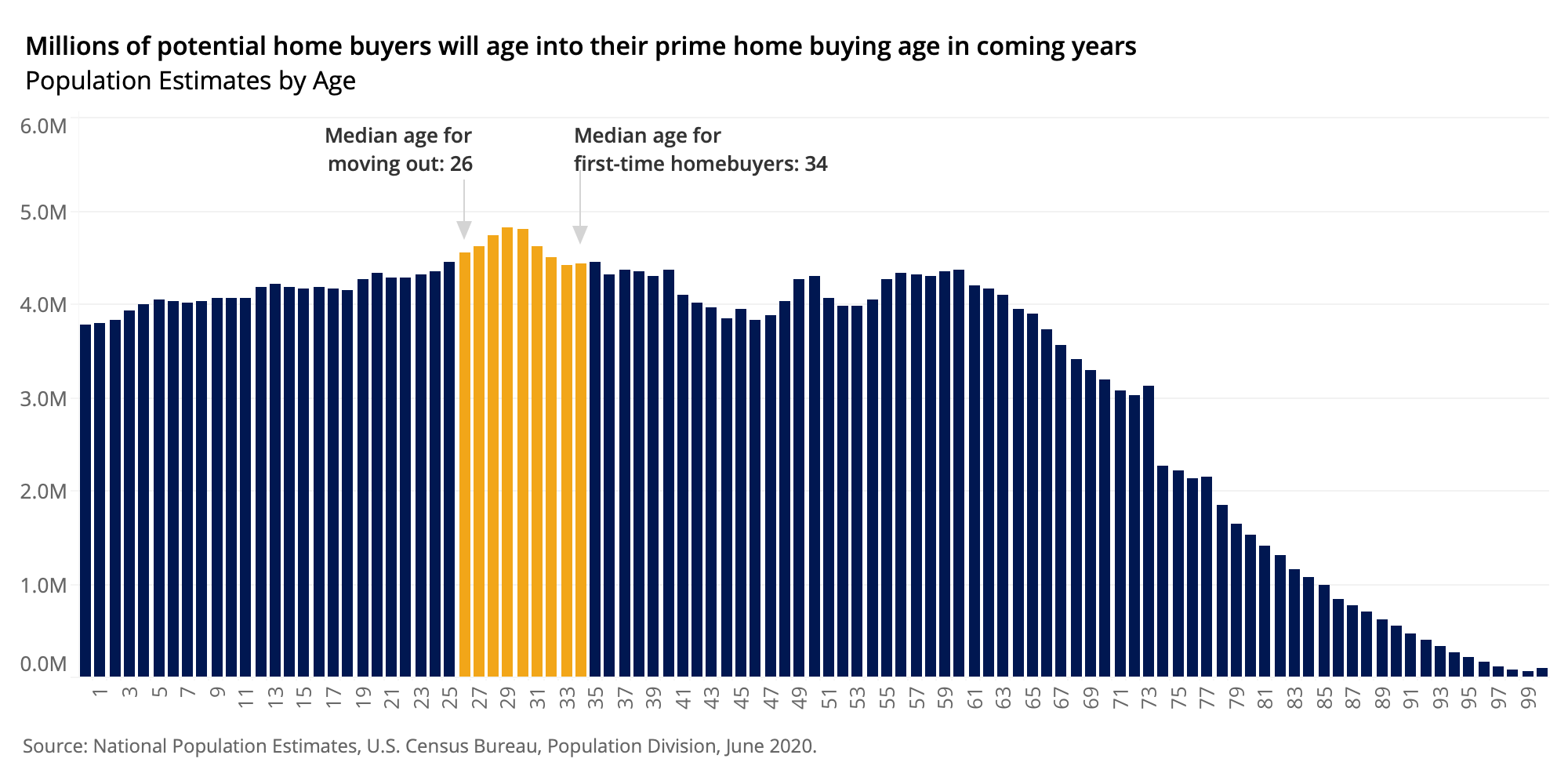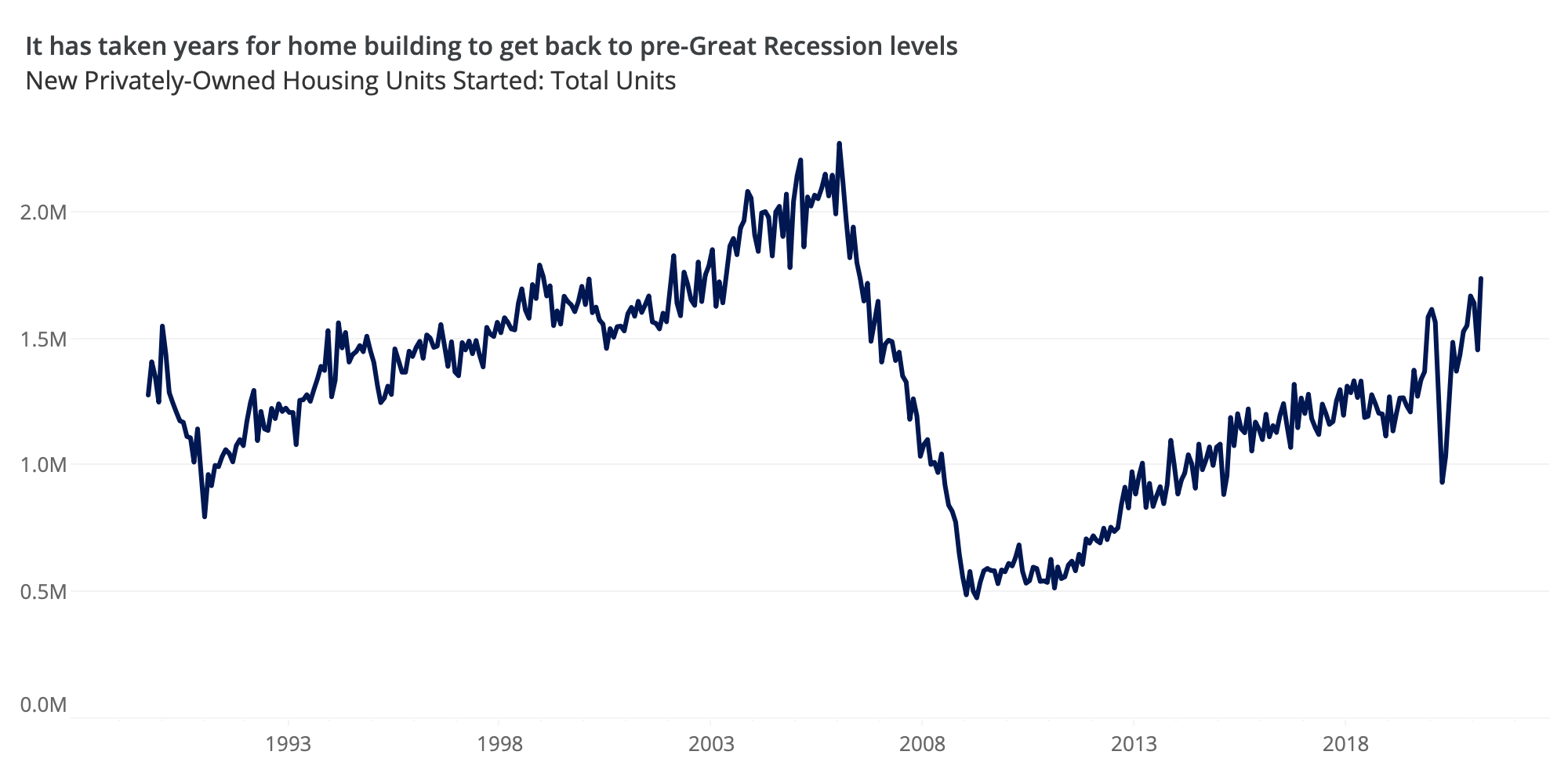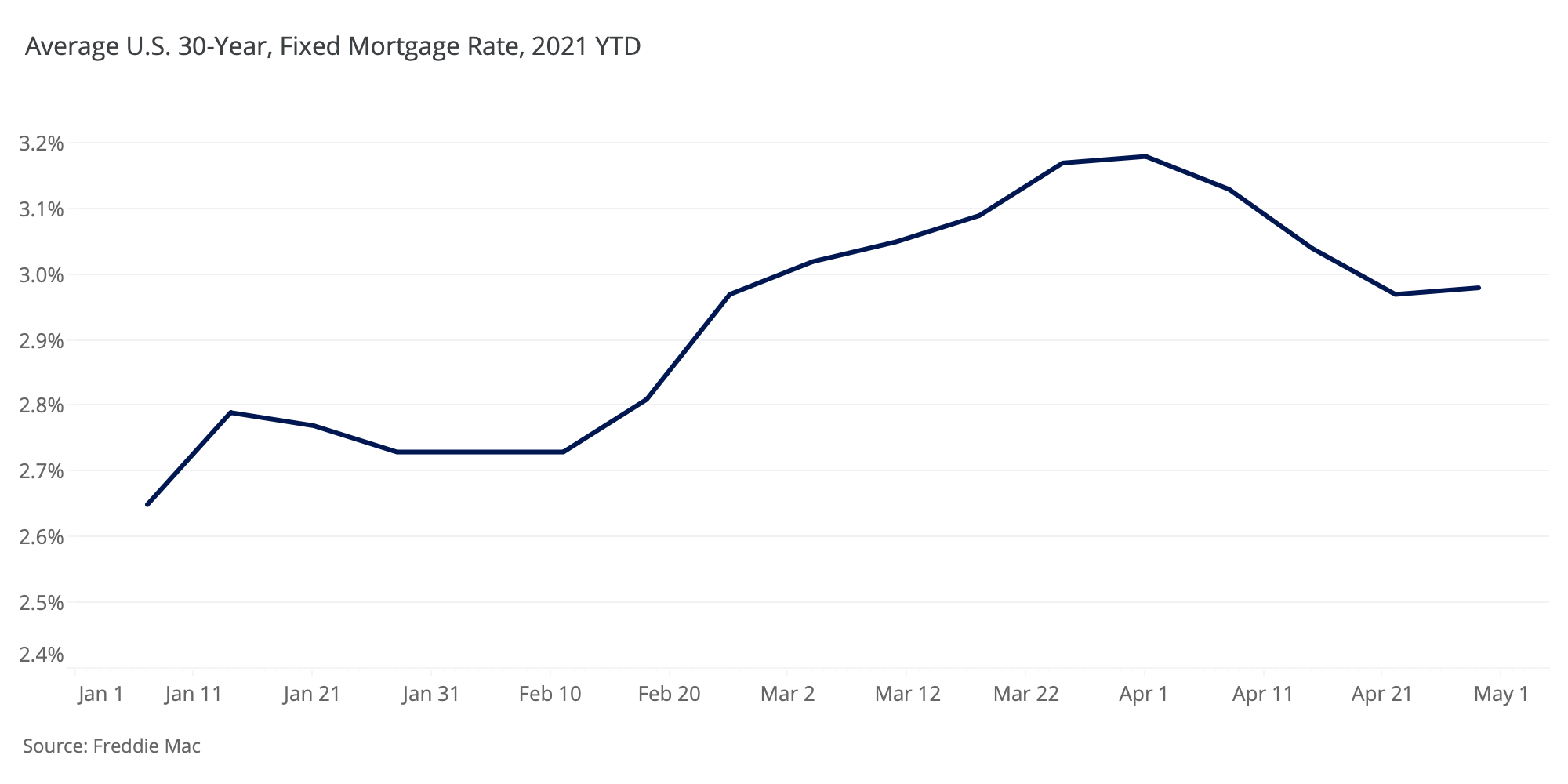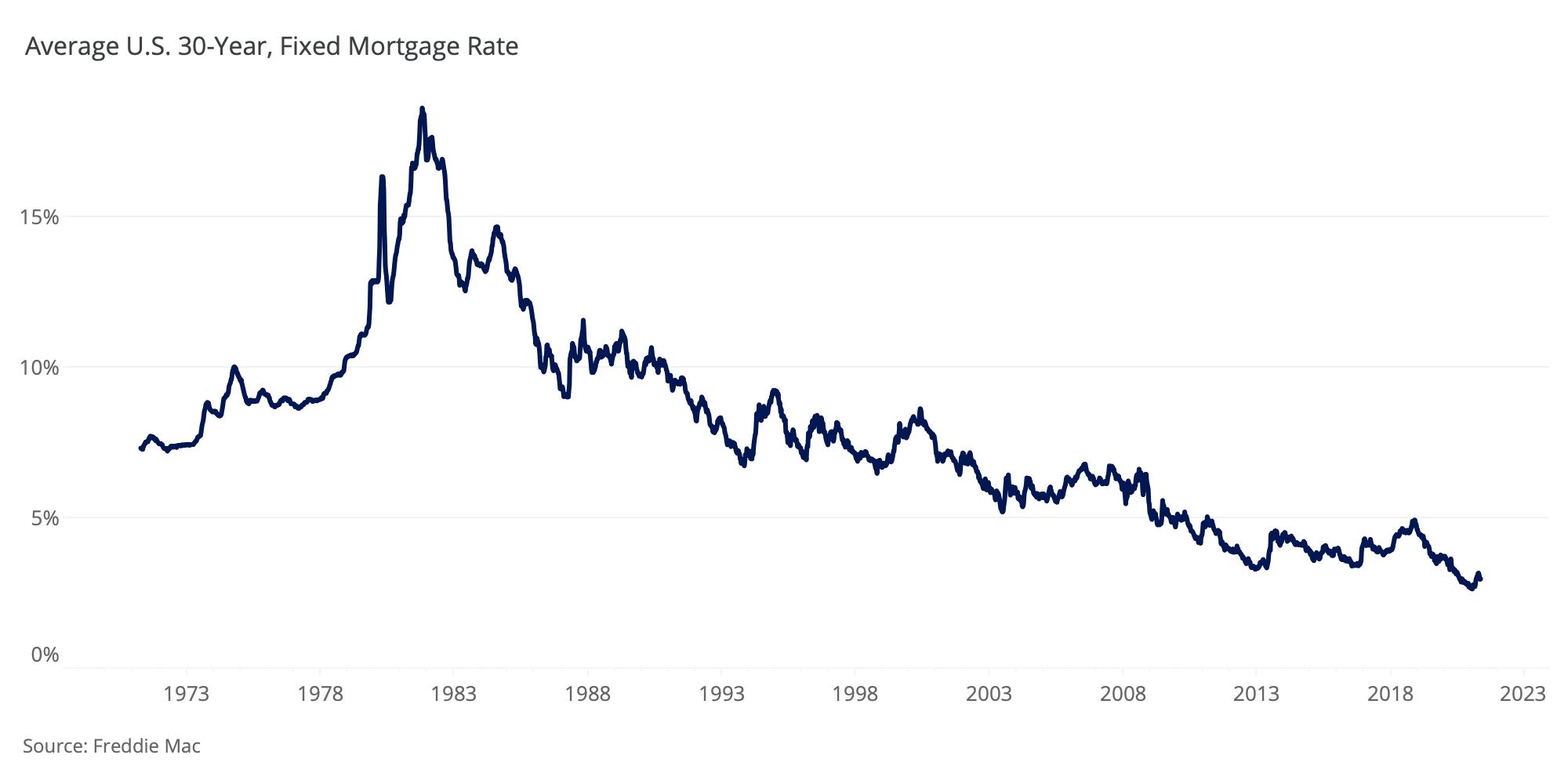
- Today’s housing fundamentals — including supply, demand and overall financial conditions — are markedly different than in 2008, and current conditions are largely sustainable.
- Housing supply is extremely tight — arguably the one factor most dramatically different today from the 2008-era market, when a wave of foreclosures following years of robust homebuilding pushed supply well ahead of demand and led prices to collapse.
- Demand will stay strong as the large millennial generation continues to age into homeownership, and more inventory is expected to soon hit the market — bringing more balance to the market and creating a smoother experience for everyone.
The great reshuffling in housing that began roughly a year ago at the outset of the pandemic — and the heightened housing demand, elevated home sales activity and rapid price appreciation that came with it — is only just beginning, and will not simply end as the pandemic slowly begins to recede. Housing demand will stay strong, sales volumes will continue to grow and more balance between home buyers and sellers will help ensure sustainable health in housing for years to come.
Those with an eye on recent history can’t be blamed for thinking current market conditions are nearing their endgame, with rapid price appreciation and fierce competition for homes eerily reminiscent of the late stages of the mid-2000s housing boom. March marked the largest one-month increase ever recorded in the more than 25-year history of the Zillow Home Value Index — surpassing even the housing run-up preceding the Great Recession — and the 10.6% rise from March 2020 was the largest annual increase in 15 years.
But that view ignores the fact that the housing market doesn’t operate in a vacuum, and is driven by the interactions of a number of relatively simple but critically important fundamentals — including supply and demand, financial conditions and technological advancement. And the state of those fundamentals in 2021 is ultimately far healthier, and that health far more likely to be sustainable over the longer-term, than the out-of-whack fundamentals from a generation ago.
Examining each of these fundamental pieces on their own, including how each has evolved to its current point and how they are different from 2008, can help us paint a bigger picture of a housing market positioned to see the boom of the past year continue to roll on.
Demand
Demand for housing has steadily grown in recent years, driven by a number of factors that are fundamentally different from 2008: longer-running demographic shifts, continued recovery from the Great Recession, and recent pandemic-related housing considerations and low mortgage rates that have pushed demand into overdrive.
Millennials are aging into their prime home-buying ages & overcoming obstacles
Unlike 2008, when a large portion of demand was driven by somewhat artificial factors that ultimately turned out to be unsustainable, including easy access to cheap mortgage financing, demand today and going forward is driven by several largely healthy and durable trends we expect to continue for years.
The first factor driving demand is a huge demographic shift that has been steadily unfolding for the past several years. The massive millennial generation — some 72 million strong in 2019 — the oldest of whom are approaching their 40s, is aging into their prime career-building, family-starting and home-buying years. The median age of first-time home buyers is generally in the early-mid thirties, and there are tens of millions of Americans at or approaching that threshold.

The combined numbers of millennials turning 34 over the next decade — the median age of first-time home buyers in 2019 — is roughly 46 million, the largest such number expected to reach that age in a single decade (The previous record prior to the Millennial generation was in 1989, when there were about 43 million 25-34 year old Boomers). And as millennials age, there are millions more of their younger peers in Gen Z behind them waiting in the wings. It adds up to millions of potential new buyers in years to come — representing “built-in” demand that is extremely unlikely to fade even if market conditions change in coming years.
A number of factors contributed to a slow start among the millennial generation in achieving homeownership, including stagnant income growth over the past decade, rising student debt burdens and the ongoing inventory crunch that limited access to entry-level homes more than most. There would be some 5.7 million additional households today if Americans formed households at the same rate they did in 2006. This is a testament to widespread difficulties in securing affordable, accessible housing over the past decade-plus, but also another potential indicator of enduring housing demand to come. But even at today’s lower levels of household formation, there will still be 6.4 million more households in 2025 than there are today, simply because so many millennials are aging into their late 30s and wanting/needing to strike out on their own.
The pandemic sparked a Great Reshuffling that is in its early stages
In addition to this demographic-driven demand, the coronavirus pandemic itself drove housing demand even higher. Suddenly, many Americans who were no longer commuting and were instead spending almost all of their time at home were left with an entirely new set of criteria when considering what they wanted their home to be.
But rather than acting as a one-time demand stimulus, there are ample reasons to believe these reshuffling and reconsideration trends have only just begun. An overwhelming majority (95%) of experts recently surveyed by Zillow said the consumer preference for working from home at least part-time will be an enduring legacy of the pandemic. Prior Zillow research found that almost 2 million U.S. renters that currently can’t comfortably afford to buy an entry-level home in their current metro area could potentially afford the nation’s typical starter home if they took advantage of increased telework options and moved to a less-expensive locale. As more companies consider making more-flexible work-from-home arrangements permanent, the future boost to demand could be significant.
Historically low mortgage rates boost buying power
This wave of buyers already in or soon-to-enter the market do face challenges given the limited number of homes available to buy (more on that below) and cutthroat competition. But buyers today who can qualify for a loan, save an adequate down payment and find a home to buy do enjoy some advantages over buyers from previous generations — namely, historically low mortgage interest rates, which help stretch buyers’ budgets by keeping monthly payments relatively affordable.
It’s likely these low interest rates pulled some demand forward in 2020 — bringing buyers into the market sooner than they might have otherwise planned so they could lock in a low rate and avoid the possibility that rates would be higher if they stuck to their original timeline. But rather than serving to boost demand today at the expense of tomorrow, the pool of current and coming millennial and Gen Z buyers is very likely more than deep enough to ensure that won’t happen.
Supply
The glaring lack of homes available to buy relative to robust demand is probably the most visible (or invisible) trend defining the housing market in 2021. This mismatch between limited supply and sky-high demand is the single-largest factor driving home values up at a record pace, and the time homes spend on the market before selling to record lows. It is also arguably the one factor most dramatically different from the 2008-era market, when a wave of foreclosures following years of robust homebuilding pushed supply well ahead of demand and led prices to collapse.
It has taken years for home building to get back to pre-2008 levels
There were less than 1 million homes listed for sale nationwide in March (966,970), down 1.1% from February and 32% from March 2020 — the 18th straight month of annual declines, and the 12th consecutive month those declines have exceeded 10%.
There is no single reason that explains the current housing deficit. Instead, it is a mix of broad short- and longer-term trends that came together last year and are continuing to play out as the market moves forward. Longer-term, in the years immediately following the Great Recession, home building activity fell far below what was needed to keep pace with population growth, as builders worked through a glut of unsold supply left over from the last gasps of the housing boom. Burned by this excess, it would take more than a decade for builders to again reach 1.6 million housing starts in a month — a level that consistently represented the floor and not the ceiling of building activity throughout the early-mid 2000s. And building is desperately needed — the homeowner vacancy rate was just 0.9% in Q1 2021, tied for the lowest single quarterly rate, prior to 2020, since 1978; the last time the four-quarter rolling average of homeowner vacancy was as low as it is currently was 1957. When there are so few vacant homes to sell and potentially add to supply, building needs to fill much of the void.

Pandemic uncertainty left many potential sellers on the sidelines
More recently, housing supply has been constrained by a number of shorter-term factors that are likely to ease in coming months and years. Many homeowners in search of more space or safety were pushed to move because of the pandemic. But the coronavirus also introduced broad uncertainty and anxiety into the market, pushing many would-be sellers to reconsider listing their homes for sale and exposing themselves to perceived health risks if they didn’t absolutely have to. And the ongoing shortage of homes itself may also have created a self-reinforcing cycle of housing musical chairs: Potential sellers were afraid of standing up and listing their home for sale, lest they find themselves unable to find a different home to settle into.
Low inventory hasn’t meaningfully slowed home sales
It’s worth noting here that the number of closed home sales continued to grow in late 2020 and into 2021, even as overall inventory plummeted. Zillow forecasts 6.4 million home sales in 2021, which would be up 13.5% from a robust 2020 and the strongest calendar year for sales since 2006.
The deciding factor allowing both low inventory and high sales is a drastic acceleration in the speed of the market itself, with buyers snapping up newly listed homes just days after they hit the market. Much of this was driven by necessity, and the need to act quickly to beat out competitors. But it was helped by increased adoption of new ways to discover, tour and ultimately transact on the homes we buy, which won’t fade with the pandemic. Nearly 60% of millennials say they would be at least somewhat comfortable making an offer on a home without touring in person if they’ve viewed a virtual tour, and almost 40% even say they would be comfortable buying a home online. And 79% of Americans say they’d like to view a 3D virtual tour while shopping for a home.
The inventory winds appear to be changing
Looking ahead, these dynamics working to keep inventory low appear to be changing for the better. More than two-thirds (69%) of a panel of real estate experts and economists recently surveyed by Zillow said they expect inventory will begin to grow in the second half of this year or the first half of 2022, for a number of reasons. Homeowners representing eight million households say they’re more likely to move and sell their home as a result of the pandemic. And widespread coronavirus vaccine distribution will make homeowners in 14 million households feel comfortable moving who don’t necessarily feel that way now.
This shift may already be underway. While the early weeks of 2021 were marked by a scarcity of new home listings as sellers stayed on the sidelines in the face of an uptick in COVID-19 cases and a string of harsh winter weather, our data indicate they are starting to come back. New listings nationwide rose by 30% in the four weeks between late February and late March. A rapid pace of sales meant total inventory continued to decline in March, but the 1.1% monthly decline from February was the smallest since July 2020, and follows much larger monthly drops of 7.5% and 8.1% in February and January, respectively. Locally, inventory was actually up month-over-month in March in 19 of the nation’s 50 largest metros — no large metros experienced monthly inventory gains in February.
Builders, too, are doing their part and ramping up activity to levels not seen since prior to the Great Recession. Home building is not a particularly fast-moving process, and it will take time for builders to fully make up a years-long building deficit — especially as the costs of land, labor and especially lumber and other key materials keeps rising. But builder confidence is near all-time levels, the permit pipeline for future projects is strong and sustainable housing demand is a big reason for this change in fortunes.
Financial Conditions
Today’s economic landscape presents a mixed picture as it relates to the housing market. Certainly the widespread job loss during the pandemic has left many households behind on their housing payments or missing out on savings that could eventually be used for a down payment. But historically low mortgage rates appear likely to remain for the foreseeable future, keeping monthly payments low and stretching would-be buyers’ budgets. This will make homeownership easier to achieve for those that can qualify for a loan, save an adequate down payment and find a home in their price range.
Mortgage rates are near all-time lows
Low mortgage interest rates help to bolster buyers’ budgets even amid rapid price growth. It might be tempting to think the advantages enjoyed by buyers in 2020 — when rates reached all-time lows — are behind us, based on recent increases in rates on the standard, 30-year, fixed-rate mortgage.

But that ignores the longer view. Despite recent increases (moderated by a subsequent pull back in April), the fact is that mortgage interest rates are still in the lowest range they’ve ever been: Lower than the runup to the housing bust in 2008, lower than the economic boom that prevailed throughout the 1990s, and MUCH lower than prevailing rates in the 1980s when Baby Boomers were buying their first homes.

This sustained period of low rates has helped make homeownership more accessible and affordable for millions — especially compared to renting. As of January 2021, households that owned their home could expect to spend just 17.65% of their household income on their monthly housing payments, down from almost 20% just two years earlier. For reference, typical benchmarks say a household should not spend more than 30% of their income on a mortgage without being considered ”housing cost-burdened.”
The same point remains true even after accounting for lower incomes, smaller down payments, the past few months of appreciation and rising rates. Assuming median household income (which is lower than the median income of homeowning households) and a more-modest down payment of only 5% instead of the benchmark 20%, the monthly mortgage payment on the typical U.S. home in March would represent only about 27.2% of median household income.[1] In February 2007, when home values hit a then-record high before beginning a five-year decline, the monthly cost of the mortgage on a typical home using the same assumptions and interest rates at the time was about 39.8% of the median household income.[2]
Despite almost a decade of often rapid home value appreciation, affordability today is much closer to where it was in February 2012 (24.7%)[3] — when home values hit their lowest point post-Great Recession, representing a remarkable bargain for buyers — than during the pre-recession years. The relative stability in home affordability over this period can be attributed in part to modest income gains, but more fully to the steady decline in mortgage interest rates that helped blunt the impact of rising home values.
The beneficial impact of low rates is obvious, but it’s also critical to acknowledge several important realities — namely, that low mortgage interest rates don’t do anything to help buyers clear the largest hurdle to homeownership: Saving for a down payment. As home prices have grown, so has the amount necessary for even a minimal down payment. In this sense, continued job growth and income gains — particularly among today’s renters aiming to become tomorrow’s buyers — will be essential to ensure savings rates stay sufficient to keep the pipeline of buyers full.
The pandemic has taken a heavy financial toll, but a foreclosure crisis is unlikely
None of this is to sweep the enormous economic challenges of the past year — and those that still remain — under the rug. Millions of homeowners in financial distress have applied for forbearance protection against delinquent payments on their mortgages, bringing back heartbreaking memories of the late-2000s foreclosure crisis. And more than 4 million American renters say they are at risk of eviction.
But while some will ultimately lose their home, it’s likely that a large majority will not end up in foreclosure or receive an eviction notice — a panel of experts surveyed by Zillow in Q4 2020 said that 18% of the more than 2 million homeowners then in forbearance would ultimately be foreclosed upon. The share of at-risk renters who are evicted could be even smaller if landlords work with tenants on a mutually beneficial solution rather than pursuing eviction.
These are large numbers, but nowhere near the foreclosure-crisis levels that persisted for years during the worst of the recession. And tens of billions of dollars in approved federal aid for distressed renters and homeowners included in past congressional recovery packages is also available to help cushion the blow.
A big reason that the foreclosure wave that characterized the last recession is not expected to materialize in the wake of the 2020 recession — despite massive levels of unemployment and financial damage — is because of the recent strength of housing itself over the past several years. Housing was a main cause of the last recession, and falling home values pushed many homeowners into negative equity, or “underwater” — owing more on their mortgage than their home was reasonably worth on the open market. The negative equity rate peaked at 31.2% in Q1 2012, meaning almost a third of all U.S. homeowners with a mortgage were underwater at the time. When a homeowner is in negative equity, it can be very difficult to sell their home on the open market, leaving them few options if they can no longer afford to make their monthly payments. As a result, millions were foreclosed upon.
But today’s conditions are vastly different. Housing didn’t cause this recession, and instead has been a rare economic bright spot over the past year. A homeowner who purchased their home even as late as 2018 or 2019 that is facing financial difficulties today still has the advantage of having enjoyed many months of rapid gains in equity as home values have appreciated across the country. This gives them more options to potentially sell their home, even at a profit, rather than face foreclosure.
And so:
All of this adds up to a market that is resting on well-developed, and largely sustainable fundamentals. Just because the headline statistics around rapid home value growth appear the same, rest assured that 2021 will NOT end up as a repeat of 2008. Demand will stay strong, and more inventory will soon hit the market — bringing more balance to the market and creating a smoother experience for everyone. Distressed homeowners and would-be buyers have more of a safety net today than in 2008, and the economic recovery that took years to materialize a generation ago is already underway as vaccines roll out and businesses reopen.
[1]Assuming a purchase price of $276,717 (the March level of the U.S. Zillow Home Value Index) with a 3.08% interest rate and a 5% down payment, the monthly payment would be $1,558, using standard assumptions about property taxes and insurance. The 2019 median household income was $68,703, or $5,725 per month.
[2]Assuming a purchase price of $215,486 (the February 2007 level of the U.S. Zillow Home Value Index) with a 6.29% interest rate and a 5% down payment, the monthly payment would be $1,666, using standard assumptions about property taxes and insurance. The 2007 median household income was $50,233, or $4,186 per month.
[3]Assuming a purchase price of $162,321 (the February 2012 level of the U.S. Zillow Home Value Index) with a 3.89% interest rate and a 5% down payment, the monthly payment would be $1,052, using standard assumptions about property taxes and insurance. The 2012 median household income was $51,017, or $4,251 per month.
The post History Not Repeating: Why Today’s Housing Market Won’t Turn into 2008’s appeared first on Zillow Research.
See original article here.

